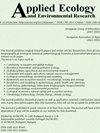TRACE METAL ENVIRONMENTAL CONTAMINATION RECORDS IN CORE SEDIMENTS OF GORGAN BAY IN THE SOUTHEAST OF THE CASPIAN SEA
IF 0.6
4区 环境科学与生态学
Q4 ECOLOGY
引用次数: 2
Abstract
In this study five sedimentary cores were collected from Gorgan Bay (southeastern part of the Caspian Sea). Concentrations of elements were measured to determine depositional trends and geostatistical assessment of toxic elements was carried out. Al, Fe, K, Mg, Na and S content increased in all 5 cores, from the bottom to near the top layer, with maximum concentrations at 15–45 cm depths. However, for the toxic elements, maximum concentration of As, Cr, Cu, Pb, Zn, Co and Ni varied in different depth of 5-15 cm and 80-120 cm. Enrichment factors (EFs) and pollution load index (PLI) were calculated to assess the enrichment and pollution of heavy elements in the bay sediments. Except for Ca and S, all studied elements showed positive and significant correlations with Fe and Al, which indicate the same source (human or natural). Principal component analysis (PCA) indicated that sediments were influenced by both geologic and anthropogenic impacts. According to the EFs, most toxic elements showed no significant enrichment and no pollution in the core sediments. Based on PLI average value in all cores, the southeast coast of the Caspian Sea (Gorgan Bay) should be classified as not metal polluted, but in recent decades there has been a dramatic increase of toxic elements that needs more attention and also里海东南部戈尔根湾岩心沉积物痕量金属环境污染记录
本研究在里海东南部的戈尔根湾采集了5个沉积岩心。测量了元素浓度以确定沉积趋势,并对有毒元素进行了地质统计评估。5个岩心中Al、Fe、K、Mg、Na和S的含量均呈自下而上向近顶层上升的趋势,在15 ~ 45 cm处浓度最高。而有毒元素As、Cr、Cu、Pb、Zn、Co、Ni的最大浓度在5 ~ 15 cm和80 ~ 120 cm不同深度存在差异。通过计算富集因子(EFs)和污染负荷指数(PLI)来评价海湾沉积物中重元素的富集和污染程度。除Ca、S外,其余元素均与Fe、Al呈显著正相关,表明来源相同(人为或自然)。主成分分析(PCA)表明,沉积物受到地质和人为双重影响。结果表明,大多数有毒元素在岩心沉积物中没有明显富集,也没有污染。根据各岩心的PLI平均值,里海东南海岸(戈尔根湾)应被归类为非金属污染,但近几十年来,有毒元素急剧增加,需要引起更多的关注和重视
本文章由计算机程序翻译,如有差异,请以英文原文为准。
求助全文
约1分钟内获得全文
求助全文
来源期刊

Applied Ecology and Environmental Research
ECOLOGY-ENVIRONMENTAL SCIENCES
CiteScore
1.40
自引率
14.30%
发文量
104
审稿时长
14 months
期刊介绍:
The Journal publishes original research papers and review articles. Researchers from all countries are invited to publish pure or applied ecological, environmental, biogeographical, zoological, botanical, paleontological, biometrical-biomathematical and quantitative ecological or multidisciplinary agricultural research of international interest on its pages.
The focus is on topics such as:
-Community, ecosystem and global ecology-
Biometrics, theoretical- and quantitative ecology-
Multidisciplinary agricultural and environmental research-
Sustainable and organic agriculture, natural resource management-
Ecological methodology, monitoring and modeling-
Biodiversity and ecosystem research, microbiology, botany and zoology-
Biostatistics and modeling in epidemiology, public health and veterinary-
Earth history, paleontology, extinctions, biogeography, biogeochemistry-
Conservation biology, environmental protection-
Ecological economics, natural capital and ecosystem services-
Climatology, meteorology, climate change, climate-ecology.
The Journal publishes theoretical papers as well as application-oriented contributions and practical case studies. There is no bias with regard to taxon or geographical area. Purely descriptive papers (like only taxonomic lists) will not be accepted for publication.
 求助内容:
求助内容: 应助结果提醒方式:
应助结果提醒方式:


